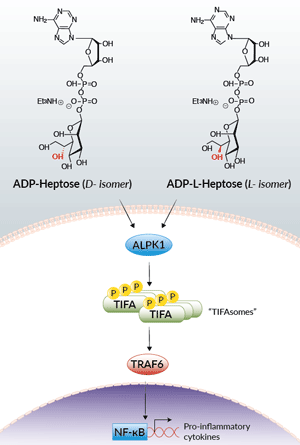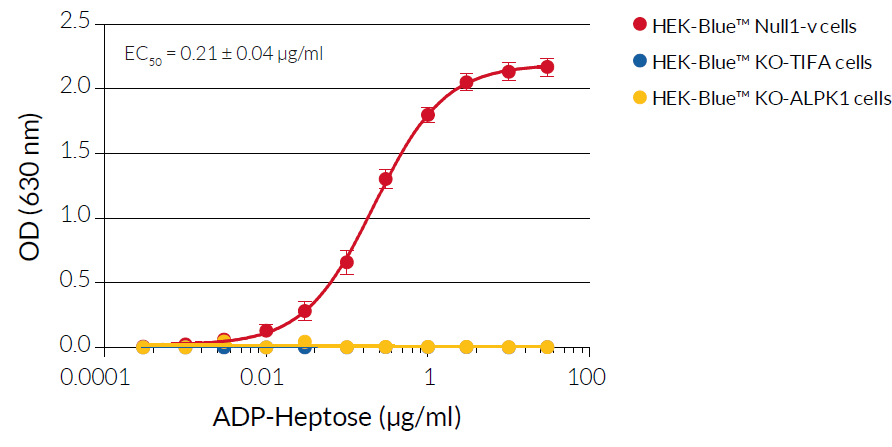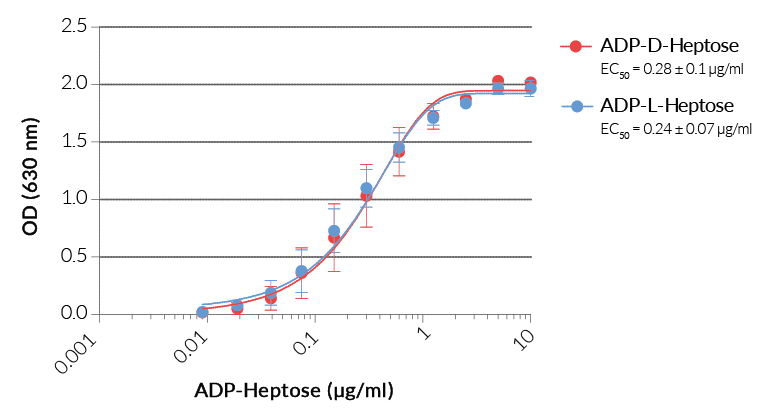ADP-Heptose (L-isomer)
| Product | Unit size | Cat. code | Docs. | Qty. | Price | |
|---|---|---|---|---|---|---|
|
ADP-L-Heptose ALPK1 ligand - L isomer |
Show product |
250 µg |
tlrl-adph-l
|
|
Synthetic ALPK1-TIFA inducers

ADP-Heptose (D- & L-isomer) induced ALPK1-TIFA signaling
Bacterial ADP-Heptose is an intermediary sugar in the biosynthesis of lipopolysaccharide (LPS), an essential component of the outer membrane of Gram-negative bacteria. It is generated by a multi-step biosynthesis pathway, in which the final step is the interconversion between two isomers, ADP-D-glycero-β-D-manno-heptose and ADP-L-glycero-β-D-manno-heptose, catalyzed by an epimerase enzyme (e.g. HldD). Importantly, synthetic forms of the D- and L- isomers of ADP-Heptose have been shown to trigger comparable NF-κB-dependent signaling in vitro [1-3].
InvivoGen has synthesized and provides the L-isomer, ADP‑L-Heptose– ADP-L-glycero-β-D-manno-heptose.
Both isomers of ADP-Heptose have been identified as potent PAMPs from Gram-negative bacteria that bind to the cytosolic receptor, ALPK1 [1-3]. By binding to ALPK1, ADP-Heptose triggers the oligomerization of TIFA and the recruitment of TRAF6. Ultimately, this results in the activation of NF-κB and a strong pro-inflammatory response [1].
Key features:
- Potent LPS-intermediary metabolite produced by all Gram-negative bacteria
- Activates the cytosolic ALPK1-TIFA signaling pathway
- Easily penetrates the cell wall for delivery to the host cell cytoplasm
InvivoGen's ADP-L-Heptose is of the highest quality, guaranteed free of bacterial contamination, and has been functionally validated on HEK-Blue™ Null1-v cells. Additionally, to foster research into ADP-Heptose-dependent signaling, InvivoGen provides HEK-Blue™ KO-ALPK1 and HEK-Blue™ KO-TIFA cells.
References:
1. Pfannkuch, L. et al. 2019. ADP heptose, a novel pathogen-associated molecular pattern identified in Helicobacter pylori. FASEB J, fj201802555R.
2. Garcia-Weber, D. et al. 2018. ADP-heptose is a newly identified pathogen-associated molecular pattern of Shigella flexneri. EMBO Rep 19
3. Zhou, P. et al. 2018. Alpha-kinase 1 is a cytosolic innate immune receptor for bacterial ADP-heptose. Nature 561, 122-126.
Specifications
Formula: C17H27N5O16P2 . Et3NH (stable form)
Molecular weight: 720.21 g/mol (stable form)
Isomer: L isomer
Solubility: 10 mg/ml in H2O
Working concentration: 0.01 - 30 µg/ml
Quality Control
- Purity >95% (UHPLC)
- Activation of the ALPK1/TIFA signaling pathway has been confirmed using a cellular assay.
- The absence of bacterial contamination (i.e. endotoxins) has been confirmed using a kinetic chromogenic LAL assay, with an endotoxin level <1 EU/mg.
Contents
- 250 µg of ADP-L-Heptose (provided as a dried powder)
- 1.5 ml of endotoxin-free water
![]() Product is shipped at room temperature.
Product is shipped at room temperature.
![]() Store at -20°C. Upon resuspension, prepare aliquots and store at -20°C.
Store at -20°C. Upon resuspension, prepare aliquots and store at -20°C.
![]() The resuspended product is stable for 3 months at -20°C.
The resuspended product is stable for 3 months at -20°C.
![]() Avoid repeated freeze-thaw cycles.
Avoid repeated freeze-thaw cycles.








